Cardiovascular involvement after liver transplantation: role of non-alcoholic fatty liver disease and non-alcoholic steatohepatitis
Patients submitted to liver transplantation (LT) are exposed to high risk of cardiovascular (CV) complications which are the main determinants of both short-term and long-term morbidity and mortality in LT. Non-alcoholic fatty liv
[...] Read more.
Patients submitted to liver transplantation (LT) are exposed to high risk of cardiovascular (CV) complications which are the main determinants of both short-term and long-term morbidity and mortality in LT. Non-alcoholic fatty liver disease (NAFLD) is a very frequent condition in general population and is associated with a high risk of cardiovascular disease (CVD) which represents the first cause of death of these patients. NAFLD is predicted to become the first indication to LT and nowadays is also frequently detected in patients submitted to LT for other indications. Thus, the risk of CVD in patients submitted to LT is forecasted to increase in the next years. In this review the extent of CV involvement in patients submitted to LT and the role of NAFLD, either recurring after transplantation or as de novo presentation, in increasing CV risk is analysed. The risk of developing metabolic alterations, including diabetes, hypertension, dyslipidemia and weight gain, all manifestations of metabolic syndrome, occurring in the first months after LT, is depicted. The different presentations of cardiac involvement, represented by early atherosclerosis, coronary artery disease, heart failure and arrhythmias in patients with NAFLD submitted to LT is described. In addition, the tools to detect cardiac alterations either before or after LT is reported providing the possibility for an early diagnosis of CVD and an early therapy able to reduce morbidity and mortality for these diseases. The need for long-term concerted multidisciplinary activity with dietary counseling and exercise combined with drug treatment of all manifestations of metabolic syndrome is emphasized.
Rosa Lombardi ... Anna Ludovica Fracanzani
View:2862
Download:40
Times Cited: 0
Patients submitted to liver transplantation (LT) are exposed to high risk of cardiovascular (CV) complications which are the main determinants of both short-term and long-term morbidity and mortality in LT. Non-alcoholic fatty liver disease (NAFLD) is a very frequent condition in general population and is associated with a high risk of cardiovascular disease (CVD) which represents the first cause of death of these patients. NAFLD is predicted to become the first indication to LT and nowadays is also frequently detected in patients submitted to LT for other indications. Thus, the risk of CVD in patients submitted to LT is forecasted to increase in the next years. In this review the extent of CV involvement in patients submitted to LT and the role of NAFLD, either recurring after transplantation or as de novo presentation, in increasing CV risk is analysed. The risk of developing metabolic alterations, including diabetes, hypertension, dyslipidemia and weight gain, all manifestations of metabolic syndrome, occurring in the first months after LT, is depicted. The different presentations of cardiac involvement, represented by early atherosclerosis, coronary artery disease, heart failure and arrhythmias in patients with NAFLD submitted to LT is described. In addition, the tools to detect cardiac alterations either before or after LT is reported providing the possibility for an early diagnosis of CVD and an early therapy able to reduce morbidity and mortality for these diseases. The need for long-term concerted multidisciplinary activity with dietary counseling and exercise combined with drug treatment of all manifestations of metabolic syndrome is emphasized.
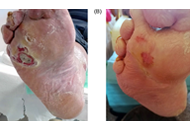 Risk factors in acute diabetic foot syndrome: analysis of 75 consecutive patients referred to a tertiary center in Modena, ItalyOpen AccessOriginal ArticleAim: Diabetic foot syndrome (DFS) is a complication of diabetes in which the presence of infections, ulceration and/or destruction of deep tissue associated with neuropathy, peripheral atherosclerosis and comorbidity affect the pr [...] Read more.Mauro Maurantonio ... Luca RoncucciPublished: February 28, 2021 Explor Med. 2021;2:98–109
Risk factors in acute diabetic foot syndrome: analysis of 75 consecutive patients referred to a tertiary center in Modena, ItalyOpen AccessOriginal ArticleAim: Diabetic foot syndrome (DFS) is a complication of diabetes in which the presence of infections, ulceration and/or destruction of deep tissue associated with neuropathy, peripheral atherosclerosis and comorbidity affect the pr [...] Read more.Mauro Maurantonio ... Luca RoncucciPublished: February 28, 2021 Explor Med. 2021;2:98–109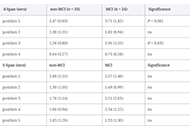 Assessing the capacity for mental manipulation in patients with statically-determined mild cognitive impairment using digital technologyOpen AccessOriginal ArticleAims: Prior research employing a standard backward digit span test has been successful in operationally defining neurocognitive constructs associated with the Fuster’s model of executive attention. The current research sought to [...] Read more.Sheina Emrani ... David J. LibonPublished: February 28, 2021 Explor Med. 2021;2:86–97
Assessing the capacity for mental manipulation in patients with statically-determined mild cognitive impairment using digital technologyOpen AccessOriginal ArticleAims: Prior research employing a standard backward digit span test has been successful in operationally defining neurocognitive constructs associated with the Fuster’s model of executive attention. The current research sought to [...] Read more.Sheina Emrani ... David J. LibonPublished: February 28, 2021 Explor Med. 2021;2:86–97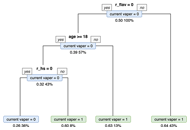 A machine learning approach to identify correlates of current e-cigarette use in CanadaOpen AccessOriginal ArticleAim: Popularity of electronic cigarettes (i.e. e-cigarettes) is soaring in Canada. Understanding person-level correlates of current e-cigarette use (vaping) is crucial to guide tobacco policy, but prior studies have not fully iden [...] Read more.Rui Fu ... Michael ChaitonPublished: February 28, 2021 Explor Med. 2021;2:74–85
A machine learning approach to identify correlates of current e-cigarette use in CanadaOpen AccessOriginal ArticleAim: Popularity of electronic cigarettes (i.e. e-cigarettes) is soaring in Canada. Understanding person-level correlates of current e-cigarette use (vaping) is crucial to guide tobacco policy, but prior studies have not fully iden [...] Read more.Rui Fu ... Michael ChaitonPublished: February 28, 2021 Explor Med. 2021;2:74–85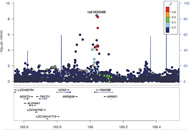 Genome-wide association study of phenotypes measuring progression from first cocaine or opioid use to dependence reveals novel risk genesOpen AccessOriginal ArticleAim: Substance use disorders (SUD) result in substantial morbidity and mortality worldwide. Opioids, and to a lesser extent cocaine, contribute to a large percentage of this health burden. Despite their high heritability, few g [...] Read more.Richard Sherva ... Lindsay A. FarrerPublished: February 28, 2021 Explor Med. 2021;2:60–73
Genome-wide association study of phenotypes measuring progression from first cocaine or opioid use to dependence reveals novel risk genesOpen AccessOriginal ArticleAim: Substance use disorders (SUD) result in substantial morbidity and mortality worldwide. Opioids, and to a lesser extent cocaine, contribute to a large percentage of this health burden. Despite their high heritability, few g [...] Read more.Richard Sherva ... Lindsay A. FarrerPublished: February 28, 2021 Explor Med. 2021;2:60–73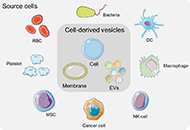 Cell-derived vesicles for delivery of cancer immunotherapyOpen AccessReviewIn recent years, cancer immunotherapy has received unprecedented attention due to the clinical achievements. The applications of biomedical engineering and materials science to cancer immunotherapy have solved the challenges cause [...] Read more.Jialu Xu, Chao WangPublished: February 28, 2021 Explor Med. 2021;2:39–59
Cell-derived vesicles for delivery of cancer immunotherapyOpen AccessReviewIn recent years, cancer immunotherapy has received unprecedented attention due to the clinical achievements. The applications of biomedical engineering and materials science to cancer immunotherapy have solved the challenges cause [...] Read more.Jialu Xu, Chao WangPublished: February 28, 2021 Explor Med. 2021;2:39–59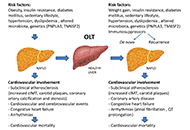 Cardiovascular involvement after liver transplantation: role of non-alcoholic fatty liver disease and non-alcoholic steatohepatitisOpen AccessReviewPatients submitted to liver transplantation (LT) are exposed to high risk of cardiovascular (CV) complications which are the main determinants of both short-term and long-term morbidity and mortality in LT. Non-alcoholic fatty liv [...] Read more.Rosa Lombardi ... Anna Ludovica FracanzaniPublished: February 28, 2021 Explor Med 2021;2:20–38
Cardiovascular involvement after liver transplantation: role of non-alcoholic fatty liver disease and non-alcoholic steatohepatitisOpen AccessReviewPatients submitted to liver transplantation (LT) are exposed to high risk of cardiovascular (CV) complications which are the main determinants of both short-term and long-term morbidity and mortality in LT. Non-alcoholic fatty liv [...] Read more.Rosa Lombardi ... Anna Ludovica FracanzaniPublished: February 28, 2021 Explor Med 2021;2:20–38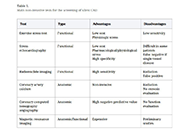 Silent coronary artery disease in type 2 diabetes: a narrative review on epidemiology, risk factors, and clinical studiesOpen AccessReviewSilent coronary artery disease (CAD) is one of the manifestations of heart disease that particularly affects subjects with type 2 diabetes mellitus (T2DM). From a clinical point of view, silent CAD represents a constant challenge [...] Read more.Saula Vigili de KreutzenbergPublished: February 28, 2021 Explor Med. 2021;2:1–19
Silent coronary artery disease in type 2 diabetes: a narrative review on epidemiology, risk factors, and clinical studiesOpen AccessReviewSilent coronary artery disease (CAD) is one of the manifestations of heart disease that particularly affects subjects with type 2 diabetes mellitus (T2DM). From a clinical point of view, silent CAD represents a constant challenge [...] Read more.Saula Vigili de KreutzenbergPublished: February 28, 2021 Explor Med. 2021;2:1–19